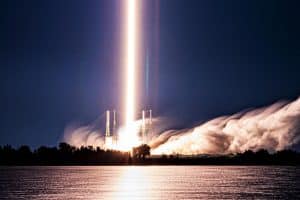- 🚀 SpaceX resumed launches after a five-day Thanksgiving break, deploying 23 Starlink satellites from Cape Canaveral Space Force Station in Florida.
- 📡 The launched Starlink satellites are V2 mini variants, equipped with argon Hall thrusters for improved maneuvering and four times more bandwidth than previous versions.
- 🛰️ This launch marked the 87th orbital mission and the 83rd of the year for the Falcon 9, with the possibility of reaching 100 launches for the year.
- 🌐 Booster 1062, used for the 17th time, successfully landed on the droneship, and fairing recovery vessel Bob attempted to retrieve the fairing halves.
- 🚀 Next up for SpaceX is a Falcon 9 launch from California, scheduled for December 1st, carrying a reconnaissance satellite for South Korea.
After a seemingly rare five-day break for Thanksgiving, SpaceX jumped right back into it with a launch of 23 Starlink satellites to low Earth orbit from Space Launch Complex 40 at Cape Canaveral Space Force Station in Florida.
Launching at 11:20 pm ET (04:20 UTC), the Falcon 9 launched to the Southeast and inserted into a 43-degree orbital inclination. This is Group 6-30, and over the next couple of months, the satellites will undergo checkouts and raise their orbits as they become fully operational.
The 23 Starlink satellites were deployed just over an hour after launch. These 23 satellites are the V2 mini variant that uses argon Hall thrusters for better maneuvering in orbit and the ability to handle four times more bandwidth than the previous V1.5 Starlink.
Previously SpaceX was only launching 22 at a time from Florida, but recently they have been able to add one more as they fine-tune the performance of the Falcon 9. The V2 mini Starlink variant weighs in at 800 kg ( 1,800 lbs), whereas the V1.5 satellites weigh just ~306 kg (675 lbs).
This was the 87th orbital mission and the 83rd of the year for the Falcon 9. SpaceX could still hit 100 launches this year as long as no unexpected delays occur, but it will be very close.
This was the 17th flight for this Falcon 9, Booster 1062, which had previously launched 9 Starlink missions, 8 astronauts on the Inspiration 4 and Axiom 1 missions, 2 communications satellites, 2 GPS III satellites, and the OneWeb internet satellite constellation that carried 40 satellites to orbit.
B1062 successfully landed on the droneship Just Read the Instructions just over eight and half minutes after liftoff, and fairing recovery vessel Bob will attempt to retrieve the fairing halves a bit further downrange before returning to Port Canaveral and eventual refurbishment.
Next up for SpaceX will be a Falcon 9 launch from California no earlier than December 1st with a reconnaissance satellite for South Korea. This launch will feature a return to the landing site following its mid-morning launch.





